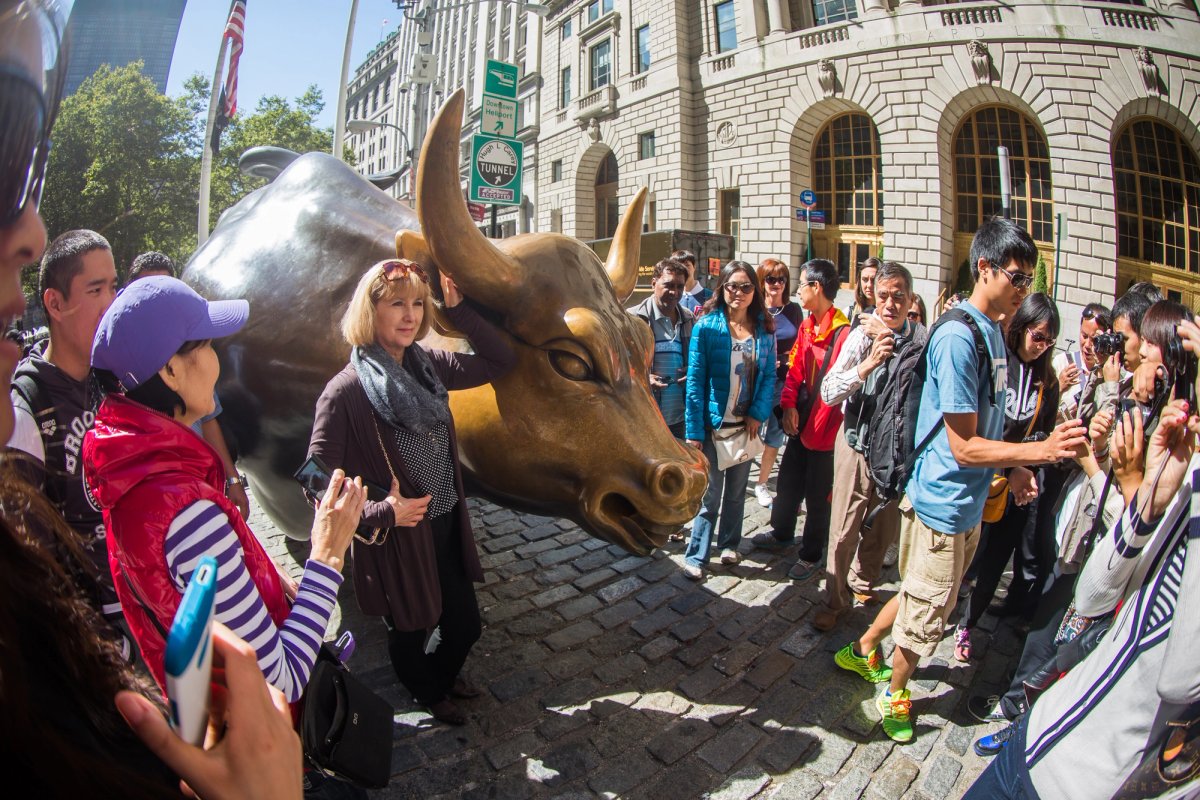The now famous Charging Bull statue first came to lower Manhattan on 15 December 1989. It was installed surreptitiously by the artist Arturo Di Modica beneath a massive Christmas tree outside of the New York Stock Exchange, and intended as a “gift of encouragement” following the market crash of 1987. The city removed the 18-foot sculpture by the end of the day, but after negotiations between parks officials and Di Modica, the bull was reinstalled on a traffic island at the northern tip of Bowling Green Park, where it has remained for the past 30 years. But Charging Bull might be moved again, against the artist’s wishes.
City officials announced last month that they intended to move the statue a few blocks north to the New York Stock Exchange, arguing that its current location on a narrow pedestrian strip surrounded by vehicular traffic poses a danger given the heavy crowds of tourists that flock to take photos and selfies with the bull. Di Modica has argued in a statement that such action “will void my copyright and trademark turning Charging Bull into the New York Stock Exchange Bull”. The artist also noted that “for 30 years, there were no accidents of any kind next to the sculpture”.
In a further twist, the New York Post published an article yesterday saying that the bull was to stay where it is. The articled noted that, in the wake of the artist’s comments, the city’s Department of Transportation withdrew its application from the Public Design Commission, which must approve the move. However, in a heated Twitter exchange, the Mayor’s deputy press secretary Jane Meyer rebuffed this assertion saying in a reply aimed at the article’s author: “I don't know how much clearer I can be about this: we are moving the Bull.”
I don't know how much clearer I can be about this: we are moving the Bull. https://t.co/UnWkMzP1gs
— Jane Meyer (@Jane__Meyer) November 13, 2019
“I think the artist has a claim in terms of trademark but not copyright,” says the art and intellectual property attorney Sam P. Israel. “With trademark, you have an override regarding whether or not something is associated with a good or a trade, which you might have in connection with the placement of the bull.” In other words, Di Modica could assert that relocating the bull to the Stock Exchange would give it a new context, and it could be argued that this changes the meaning behind the work of art. “However, copyright is not that kind of animal,” Israel added (pun unintended), and that the artist “would have much ground to stand on asserting that there's a copyright issue with relocating the bull”.
Israel added that much of the stakes are concerned with what contract Di Modica and the city originally drew up 30 years ago, as such an agreement “may or may not provide for moving the bull”. A trademark claim could still prove tricky, Israel says, especially considering that the bull initially debuted in front of the stock exchange, albeit only for a day.
“Arturo di Modica acts like he has some god-given right to keep Charging Bull where it is. What gives him a privilege that no other artist has enjoyed?” says Michele Bogart, an art historian and the author of the Politics of Urban Beauty: New York and Its Art Commission. “I don’t in fact have a clear sense of what [the sculpture’s] ownership is, but sounds like the artist still owns it. As well he should, because the sculpture was installed on City property in the late 1980s, but never went to the Art Commission of the City of New York (now the PDC) for approval. That means that it is not part of the City’s permanent collection, from a legal point of view. My sense was that the move was in part to enable the bull to become permanent by putting it through the approval process of the Public Design Commission, and thus to legalise it.”
In 2017, a new sculpture named Fearless Girl mysterious arrived at Bowling Green directly across from Charging Bull, so that it appeared the two were in a stare-down. Di Modica’s lawyers argued then that the addition dramatically altered the intent of Charging Bull, subverting it from a “positive, optimistic message” into a “a negative force and a threat”. In 2018, the four-foot Fearless Girl sculpture was moved to a new location—also by the New York Stock Exchange—though if the city’s statement is to be believed, this had less to do with Di Modica’s request and more to do with the heavy foot traffic caused by the new sculpture, which became an internet sensation.
Israel likened the artist’s rights issues around Charging Bull to an infamous incident around Richard Serra’s Tilted Arc. In 1979, Serra was commissioned to create a site-specific work for lower Manhattan’s Federal Plaza. Two months after it’s installation, a petition circulated asking for its removal, and years of legal battles ensued before the work was finally removed in 1989. Because Serra argued that to move the sculpture would be “to destroy it,” it was never reinstalled elsewhere, and has remained in storage ever since.
Bogart adds: “As with most New York City monuments, the Bull’s story is rich and complicated. It’s absurdism of the highest order, and tells us much about the complex and often contradictory workings of the monument process and about the City itself.”




